US Release date : Apr 30, 1973
Red Rose Speedway
By Paul McCartney & Wings • LP • Part of the collection “Paul McCartney • Studio albums”
Last updated on August 14, 2023
US Release date : Apr 30, 1973
By Paul McCartney & Wings • LP • Part of the collection “Paul McCartney • Studio albums”
Last updated on August 14, 2023
Previous album Apr 19, 1973 • "1967-1970 (UK version, 1973)" by The Beatles released in the UK
Interview Apr 28, 1973 • Interview with Barbara Lewis
Interview Apr 28, 1973 • Denny Seiwell interview for Record Mirror
Album Apr 30, 1973 • "Red Rose Speedway" by Paul McCartney & Wings released in the US
Article May 1973 • Wings Fun Club newsletter #2 published
Interview May 04, 1973 • Denny Laine interview for Disc And Music Echo
Next album May 04, 1973 • "Red Rose Speedway" by Paul McCartney & Wings released in the UK
This album was recorded during the following studio sessions:
Written by Paul McCartney, Linda Eastman / McCartney
3:49 • Studio version • A
Paul McCartney : Bass, Piano, Producer, Vocals Linda Eastman / McCartney : Backing vocals Denny Laine : Acoustic guitar, Backing vocals Henry McCullough : Backing vocals, Electric guitar Denny Seiwell : Drums John Kurlander : Mixing assistant engineer Glyn Johns : Recording engineer Alan Parsons : Mixing engineer Phil Ault : Recording assistant engineer
SessionRecording : Mar 06, 1972 • Studio : Olympic Sound Studios, London
SessionMixing : Jan 09, 1973 • Studio : EMI Studios, Studio Two, Abbey Road
Written by Paul McCartney, Linda Eastman / McCartney
4:12 • Studio version • A
Paul McCartney : Electric piano, Producer, Vocals Linda Eastman / McCartney : Backing vocals Denny Laine : Backing vocals, Bass Henry McCullough : Electric guitar Denny Seiwell : Drums Richard Hewson : Orchestra arrangement Mark Vigars : Assistant recording engineer Richard Lush : Mixing engineer, Recording engineer
SessionRecording : Jan 25, 1973 • Studio : EMI Studios, Abbey Road
SessionRecording : Jan 26, 1973 • Studio : EMI Studios, Abbey Road
SessionOverdubs & mixing : Jan 27, 1973 • Studio : EMI Studios, Abbey Road
Written by Paul McCartney, Linda Eastman / McCartney
4:18 • Studio version • A
Paul McCartney : Bass, Electric guitar, Piano, Vocal Linda Eastman / McCartney : Backing vocal Denny Seiwell : Drums David Spinozza : Electric guitar Tim Geelan : Recording engineer Ted Brosnan : Assistant recording engineer Richard Lush : Mixing engineer
SessionRecording : Oct 14, 1970 • Studio : CBS Studios, New York City
SessionOverdubs : March-April 1971 • Studio : Sunset Sound Recorders Studio, Los Angeles, USA
SessionMixing : Jan 21, 1973 • Studio : EMI Studios, Abbey Road
Written by Paul McCartney, Linda Eastman / McCartney
2:32 • Studio version • A
Paul McCartney : Acoustic guitar, Vocals Linda Eastman / McCartney : Electric harpsichord Denny Laine : Bass Henry McCullough : Electric guitar Denny Seiwell : Drums Mark Vigars : Assistant mixing engineer, Assistant recording engineer Alan Parsons : Mixing engineer, Recording engineer
SessionRecording : Sep 30, 1972 • Studio : EMI Studios, Abbey Road
SessionMixing : Dec 11, 1972 • Studio : EMI Studios, Abbey Road
Written by Paul McCartney, Linda Eastman / McCartney
6:20 • Studio version • A
Paul McCartney : Bass, Vocal Linda Eastman / McCartney : Backing vocal, Dingers Denny Laine : Backing vocals George Martin : Orchestra arrangement Denny Seiwell : Drums, Percussion, Vocal Hugh McCracken : Electric guitar John Kurlander : Assistant mixing engineer Tim Geelan : Recording engineer Ted Brosnan : Assistant recording engineer Alan Parsons : Mixing engineer
SessionRecording : Nov 19, 1970 • Studio : CBS Studios, New York City
Overdubs : Between March and December 1972
SessionMixing : Jan 08, 1973 • Studio : EMI Studios, Abbey Road
Written by Paul McCartney, Linda Eastman / McCartney
1:53 • Studio version • A
Paul McCartney : Backing vocals, Piano, Producer, Vocals Linda Eastman / McCartney : Backing vocals Denny Laine : Drums Denny Seiwell : Bass John Kurlander : Assistant mixing engineer Glyn Johns : Recording engineer Richard Lush : Mixing engineer Phil Ault : Assistant recording engineer
SessionRecording : Mar 09, 1972 • Studio : Olympic Sound Studios, London
SessionOverdubs & mixing : Jan 29, 1973 • Studio : EMI Studios, Abbey Road
Written by Paul McCartney, Linda Eastman / McCartney
3:41 • Studio version • A
Paul McCartney : Bass, Piano, Producer, Vocals Linda Eastman / McCartney : Backing vocals, Electric bass piano Denny Laine : Acoustic guitar, Backing vocals Henry McCullough : Acoustic guitar, Backing vocals Denny Seiwell : Backing vocals, Drums John Kurlander : Assistant mixing engineer Glyn Johns : Recording engineer Alan Parsons : Mixing engineer Phil Ault : Assistant recording engineer
SessionRecording : Mar 07, 1972 • Studio : Olympic Sound Studios, London
SessionMixing : Jan 09, 1973 • Studio : EMI Studios, Studio Two, Abbey Road
Written by Paul McCartney, Linda Eastman / McCartney
4:23 • Studio version • A
Paul McCartney : Acoustic guitar, Backing vocals, Bass, Moog, Producer Linda Eastman / McCartney : Backing vocals, Organ Denny Laine : Backing vocals, Electric guitar Henry McCullough : Backing vocals, Electric guitar Denny Seiwell : Backing vocals, Drums, Percussion Glyn Johns : Recording engineer Alan Parsons : Mixing engineer Phil Ault : Assistant recording engineer Mike Jaratt : Assistant mixing engineer
SessionRecording : Mar 15, 1972 • Studio : Olympic Sound Studios, London
SessionMixing : Jan 10, 1973 • Studio : EMI Studios, Abbey Road
Medley
Written by Paul McCartney, Linda Eastman / McCartney
11:25 • Studio version • A • Medley with "Lazy Dynamite" / "Hands Of Love" / "Power Cut"
Paul McCartney : Bass, Piano, Producer, Vocals Linda Eastman / McCartney : Backing vocals Denny Laine : Backing vocals, Electric guitar Henry McCullough : Backing vocals, Electric guitar Denny Seiwell : Backing vocals, Drums Mark Vigars : Recording assistant engineer John Kurlander : Mixing assistant engineer Alan Parsons : Mixing engineer John Leckie : Recording engineer
SessionRecording : Sep 15, 1972 • Studio : EMI Studios, Studio Two, Abbey Road
SessionMixing : Jan 14, 1973 • Studio : EMI Studios, Abbey Road
SessionMixing : Jan 16, 1973 • Studio : EMI Studios, Abbey Road
Written by Paul McCartney, Linda Eastman / McCartney
11:25 • Studio version • A • Medley with "Hold Me Tight" / "Hands Of Love" / "Power Cut"
Paul McCartney : Backing vocals, Bass, Mellotron, Piano, Producer, Vocals Denny Laine : Harmonica Henry McCullough : Electric guitar Mark Vigars : Recording assistant engineer John Kurlander : Mixing assistant engineer Alan Parsons : Mixing engineer John Leckie : Recording engineer
SessionRecording : Sep 16, 1972 • Studio : EMI Studios, Studio Two, Abbey Road
SessionMixing : Jan 14, 1973 • Studio : EMI Studios, Abbey Road
SessionMixing : Jan 16, 1973 • Studio : EMI Studios, Abbey Road
Written by Paul McCartney, Linda Eastman / McCartney
11:25 • Studio version • A • Medley with "Hold Me Tight" / "Lazy Dynamite" / "Power Cut"
Paul McCartney : Acoustic guitar, Ocarina, Producer, Vocals Linda Eastman / McCartney : Backing vocals Denny Laine : Electric guitar Henry McCullough : Percussion Denny Seiwell : Congas, Drums, Percussion Mark Vigars : Assistant recording engineer Alan Parsons : Mixing engineer, Recording engineer Mike Jaratt : Assistant mixing engineer
SessionRecording : Oct 01, 1972 • Studio : EMI Studios, Studio Two, Abbey Road
SessionMixing : Jan 13, 1973 • Studio : EMI Studios, Abbey Road
SessionMixing : Jan 16, 1973 • Studio : EMI Studios, Abbey Road
Written by Paul McCartney, Linda Eastman / McCartney
11:25 • Studio version • A • Medley with "Hold Me Tight" / "Lazy Dynamite" / "Hands Of Love"
Paul McCartney : Backing vocals, Bass, Celeste, Mellotron, Piano, Producer, Vocals Linda Eastman / McCartney : Electric piano Denny Laine : Backing vocals, Electric guitar Henry McCullough : Backing vocals, Electric guitar Denny Seiwell : Drums Mark Vigars : Recording assistant engineer John Kurlander : Mixing assistant engineer Alan Parsons : Mixing engineer, Recording engineer
SessionRecording : Oct 03, 1972 • Studio : EMI Studios, Abbey Road
SessionMixing : Jan 15, 1973 • Studio : EMI Studios, Abbey Road
SessionMixing : Jan 16, 1973 • Studio : EMI Studios, Abbey Road
Red Rose Speedway was such a non-confident record … There was “My Love” but something was missing. We needed a heavier sound … It was a terribly unsure period.
Linda McCartney to Sounds magazine, 1976
Red Rose Speedway was the live act. I mean, the album’s okay. It has its moments, but nothing approaching the impact of the band in person. After I had heard Wild Life, I thought, ‘Hell, we have really blown it here.’ And the next one after that, Red Rose Speedway, I couldn’t stand.
Paul McCartney – From “The Beatles: Off The Record 2 – The Dream is Over: Dream Is Over Vol 2” by Keith Badman
Red Rose Speedway was originally going to be a double-album. Denny wrote a song for that and I wrote a song, but then we narrowed it down.
Linda McCartney – From “The Beatles: Off The Record 2 – The Dream is Over: Dream Is Over Vol 2” by Keith Badman
I thought Red Rose Speedway was good as a double-album and more of a showcase for the band. So when it came out as a single-album, I didn’t like it as much as Ram.
Denny Laine – From “The Beatles: Off The Record 2 – The Dream is Over: Dream Is Over Vol 2” by Keith Badman
From Wikipedia:
Red Rose Speedway is the second studio album by the British–American rock band Wings, although credited to “Paul McCartney and Wings”. The album was released by Apple Records in April 1973, preceded by its lead single, the ballad “My Love“. By including McCartney’s name in the artist credit, the single and album broke with the tradition of Wings’ previous records. The change was made in the belief that the public’s unfamiliarity with the band had been responsible for the weak commercial performance of the group’s 1971 debut album Wild Life.
Before recording the album, Wings recruited lead guitarist Henry McCullough and released their debut single, “Give Ireland Back to the Irish“, which was banned by the BBC for its political message. Recording sessions for the album took place throughout 1972 at five different recording studios in London. The group also recorded the non-album singles “Mary Had a Little Lamb“, “Hi, Hi, Hi” and “Live and Let Die“, the last of which was issued in June 1973. Originally planned as a double album, it was condensed into a single LP at the request of EMI. The company believed that the material was not of a sufficiently high standard and were mindful of the modest sales of Wild Life and Wings’ first two singles. Members McCullough and Denny Laine later expressed disappointment in the choice of songs on the single album.
Red Rose Speedway peaked at number 5 on the UK Albums Chart and number 1 on the Billboard Top LPs & Tape chart in the US, while “My Love” topped the US Billboard Hot 100. Although a commercial success, the album was given a mixed response by music critics, with several reviewers considering the songs to be inconsequential and mediocre. Decades later, it continues to receive mixed reviews. The album was reissued in 1987 and 1993 with bonus tracks and remastered in 2018 as part of the Paul McCartney Archive Collection. The 2018 remaster includes the reconstructed double LP version of the album.
Background
In early 1972, McCartney decided to expand Wings to a five-piece band by adding another guitarist, Henry McCullough, and to begin touring with the group. The band briefly toured British universities in February. They played in small halls, often unannounced, to avoid the media scrutiny that came with performing at more established venues.
Despite not releasing an album in 1972, Wings issued three singles while preparing their follow-up to Wild Life: “Give Ireland Back to the Irish“, which was banned by the BBC for its political sentiments; “Mary Had a Little Lamb“, based on the nursery rhyme; and “Hi, Hi, Hi“, which was banned by the BBC for drug references and sexually suggestive lyrics.
Recording
Recording for Red Rose Speedway began in March 1972. It was initially planned as a double album, and McCartney decided to include some unreleased songs that had originally been recorded during the Ram sessions in 1971, before the formation of Wings. Two of those songs, “Get on the Right Thing” and “Little Lamb Dragonfly”, appeared on the final album. Sessions were held at Olympic Sound Studios in London, with Glyn Johns as producer. At the first session, McCartney asked Johns to think of him as “the bass player in the band” rather than as Paul McCartney, but then took offence when Johns duly treated him as an ordinary musician. Johns thought Wings were not a genuine band and not of the calibre of artist he usually worked with. Before long, according to author Howard Sounes, citing the producer’s recollection, Johns was reading a newspaper in the control room at Olympic as the group smoked marijuana and jammed aimlessly in the studio. On 17 April, Johns told the press that he had quit working on the album due to a “disagreement” with McCartney and that “Now we have respect for each other.”
Wings continued to record sporadically in between promoting their May 1972 single, “Mary Had a Little Lamb”. After the band toured Europe in July and August, further recording sessions took place over October and November 1972 at Abbey Road Studios and Olympic. Morgan, Trident and Island were the other London studios where the band recorded that year.
Red Rose Speedway was such a non-confident record. There were some beautiful songs … there was “My Love” but something was missing. We needed a heavier sound. It was a terribly unsure period.
– Linda McCartney to Sounds magazine, 1976
The album was cut down to a single disc by McCartney – according to Henry McCullough, in an attempt to release a more commercial and less expensive record. The decision came about through EMI, however; in addition to believing that the material was not of a sufficiently high standard, the record company were mindful of the modest commercial performance of Wild Life and Wings’ first two singles. The album ends with an 11-minute medley of the songs “Hold Me Tight”, “Lazy Dynamite”, “Hands of Love” and “Power Cut”, which was made in a similar style to the Beatles’ Abbey Road medley. “Power Cut” was written during the 1972 miners’ strike. Laine later expressed his disappointment that only a single album was issued, saying that in its original form, Red Rose Speedway was “more of a showcase for the band”. Among the omissions were his composition “I Would Only Smile”, and “I Lie Around“, on which Laine also sung the lead vocal. McCullough was similarly disappointed that several of McCartney’s rock-oriented tracks were cut from the running order, which favoured the more lightweight material from the sessions.
“Live and Let Die”, the title song to the James Bond film of the same name, was recorded during the sessions for Red Rose Speedway, but was initially released on the Live and Let Die soundtrack album. Laine included “I Would Only Smile” on his 1980 solo album Japanese Tears. “Mama’s Little Girl” was recorded during the sessions and later turned up as the B-side of McCartney’s “Put It There” single in 1990. Among the other discarded tracks were “Night Out”, “Jazz Street”, “Best Friend”, “Thank You Darling”, “The Mess” (which McCartney introduced on stage as “The Mess (I’m In)” during Wings’ live shows) and a cover version of Thomas Wayne’s song “Tragedy”.
Artwork and packaging
The packaging for Red Rose Speedway included a 12-page LP-size booklet inside a gatefold sleeve. The booklet featured photos from Wings’ live shows taken by Joe Stevens (credited as Captain Snap) and others by Linda. The artwork for the inside gatefold and part of the booklet was designed by Eduardo Paolozzi, while pop artist Allen Jones contributed drawings, a painting and a photo collage, all variously depicting women, throughout the booklet. The graphics were designed by Gordon House. EMI agreed to pay for the lavish packaging, which was originally intended for the planned double album.
Breaking with the approach taken on the band’s previous releases, the artist credit included McCartney’s name rather than Wings alone, and instead of a group picture, only his face appears on the front cover. The image shows McCartney in front of a motorbike engine, with a red rose in his mouth, and was taken by Linda. The motorbike was transported from the United States especially for the shoot, which took place at the photographic studio of the Sunday Times building in central London. The back cover featured the foot of a microphone stand and a bouquet of roses, with the image set inside a black background as if spotlit. In the space below this image was a Braille message to Stevie Wonder, reading “We love ya baby”.
The name change to “Paul McCartney and Wings” was made in the belief that the public’s unfamiliarity with the band had been responsible for the disappointing sales of Wild Life. In the US, Capitol Records were concerned that the positioning of the red rose on the front cover might make McCartney’s face unrecognisable to record buyers. Since no artist credit was included with this image, the company issued the album with a blue sticker in the top right-hand corner, identifying the band and listing the songs.
Release
The album was preceded by the March 1973 release of its lead single, “My Love” backed with “The Mess”. The latter song was recorded live during the band’s summer 1972 European tour. With Apple Records giving precedence to two Beatles compilation albums – 1962–1966 and 1967–1970 – Red Rose Speedway was not issued until 30 April 1973, in the United States, with the UK release following on 4 May. “My Love” peaked at number 9 on the UK Singles Chart, and topped the US Billboard Hot 100 and Billboard Adult Contemporary charts. It raised expectations for the album, which peaked at number 5 in the UK and went to number 1 in the US.
The original compact disc version, released by EMI’s Fame label on 5 October 1987, contained three bonus tracks: “I Lie Around“, “Country Dreamer” and “The Mess (Live at The Hague)”. An LP version of this CD edition was also released on the same day, omitting the bonus tracks. In 1993, Red Rose Speedway was remastered and reissued on CD as part of ‘The Paul McCartney Collection’ series, with “C Moon“, “Hi, Hi, Hi“, “The Mess (Live at The Hague)” (the B-side to “My Love”) and “I Lie Around” (the B-side to “Live and Let Die”) as bonus tracks. “Country Dreamer” was later added to the reissue Band on the Run from the same series.
In 2018, Red Rose Speedway was reissued as part of Paul McCartney Archive Collection. The bonus content included the reconstructed original double LP version of the album featuring different mixes of “Seaside Woman” and “I Would Only Smile” as to those released on Linda McCartney’s Wide Prairie and Denny Laine’s Japanese Tears respectively, the singles “Mary Had a Little Lamb“, “Hi, Hi, Hi” and “Live and Let Die” with their respective b-sides, early and rough mixes of several songs as well as previously unreleased studio and live recordings, with the latter taken from the Wings Over Europe Tour. The songs “Country Dreamer” and “Little Woman Love” included on the reissue are the same versions that were previously released on the Band on the Run and Ram editions of the Paul McCartney Archive Collection.
Critical reception
Red Rose Speedway received a mixed response from contemporary music critics, many of whom dismissed its songs as mediocre. According to author and critic Bob Woffinden, writing in 1981, the album was an example of McCartney “continu[ing] to exasperate his audience” before he and Wings finally won respect with the late 1973 release of Band on the Run. John Pidgeon of Let It Rock found the side-two medley typical of McCartney’s “lazy” attitude to songwriting and said: “Red Rose Speedway sounds as if it was written after a big tea in front of the fire with carpet-slippered feet up; listening to it takes about as much as going ten rounds with a marshmallow fairy.” Pidgeon concluded by likening the album to The Emperor’s New Clothes, ruing that McCartney appeared to have no one to challenge his judgment or “kick his arse”. Village Voice critic Robert Christgau derided McCartney’s reliance on “aimless whimsy” and described the work as “Quite possibly the worst album ever made by a rock and roller of the first rank”. In a 1977 interview, McCartney said that it typically took him a few months to listen to an album as a whole after its release; in the case of Red Rose Speedway, he said he “couldn’t stand” it. Joe Stevens, Wings’ tour photographer in the early 1970s, recalled: “I thought Red Rose was a disaster and so did everyone connected with it. Except Paul.”
According to author Michael Frontani, a generally favourable review in Rolling Stone, written by musician Lenny Kaye, signified a turnaround from a publication that had been openly hostile towards McCartney since 1970. Frontani adds: “While McCartney’s music would continue to be criticized by some commentators as vacuous and facile, Kaye’s review appears to mark the point where art of consequence was no longer required of McCartney by rock critics …” Ian Dove of The New York Times noted that McCartney’s work continued to pale beside that of his former bandmates John Lennon and George Harrison but deemed Red Rose Speedway his best album yet. Writing in the NME, Tony Tyler acknowledged that the album was “lightweight” and lacking in “intellectual posture” but added: “with all the current heaviness and after-me-the-apocalypse brainstuds around, I for one am bloody pleased to discover a lightweight record that not only fails to alienate, but actually succeeds in impressing via good melodic structure, excellent playing and fine production.”
Like the NME, Rolling Stone soon changed its opinion of Red Rose Speedway. Writing in The Rolling Stone Record Guide (1979), John Swenson said that the album displayed “the worst aspects of McCartney as solo artist and band-leader” and was “rife with weak and sentimental drivel”. In his 1977 book The Beatles Forever, Nicholas Schaffner described it as “pleasingly plump music – charming, harmless, entertaining fluff … a perfect background to lazy afternoons in the sun”.
AllMusic editor Stephen Thomas Erlewine considers Red Rose Speedway to be McCartney’s “most disjointed album” and “deliberately slight … in the way a snapshot album is important to a family yet glazes the eyes of any outside observer”, but he adds: “Work your way into the inner circle, and McCartney’s little flourishes are intoxicating – not just the melodies, but the facile production and offhand invention.” Beatles biographer Robert Rodriguez views it as “a wildly uneven assortment of songs”, of which the selections comprising the Abbey Road-style medley “aren’t merely half-finished – they’re half-assed”. While describing Glyn Johns’ disparaging comments about the finished album as “harsh”, Howard Sounes writes: “but in a record review one couldn’t award it more than three out of five stars.” […]
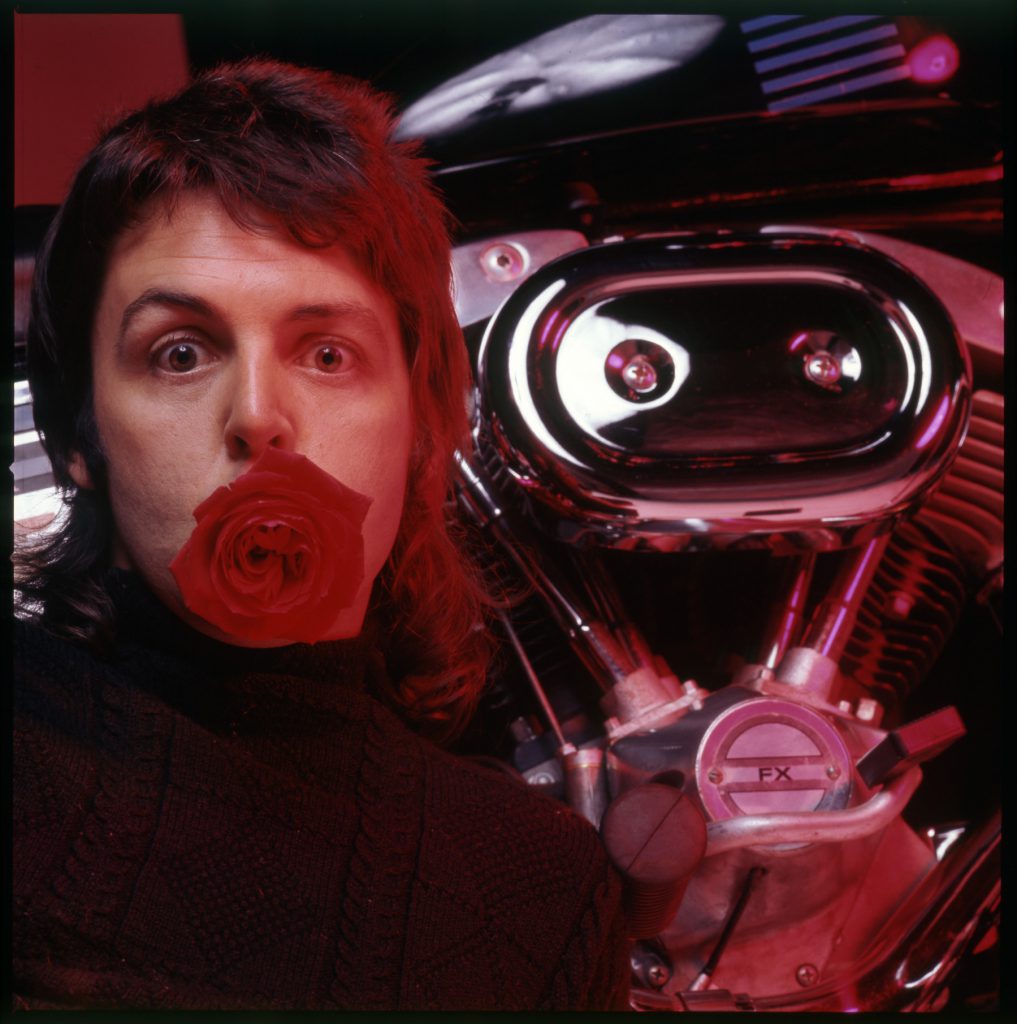
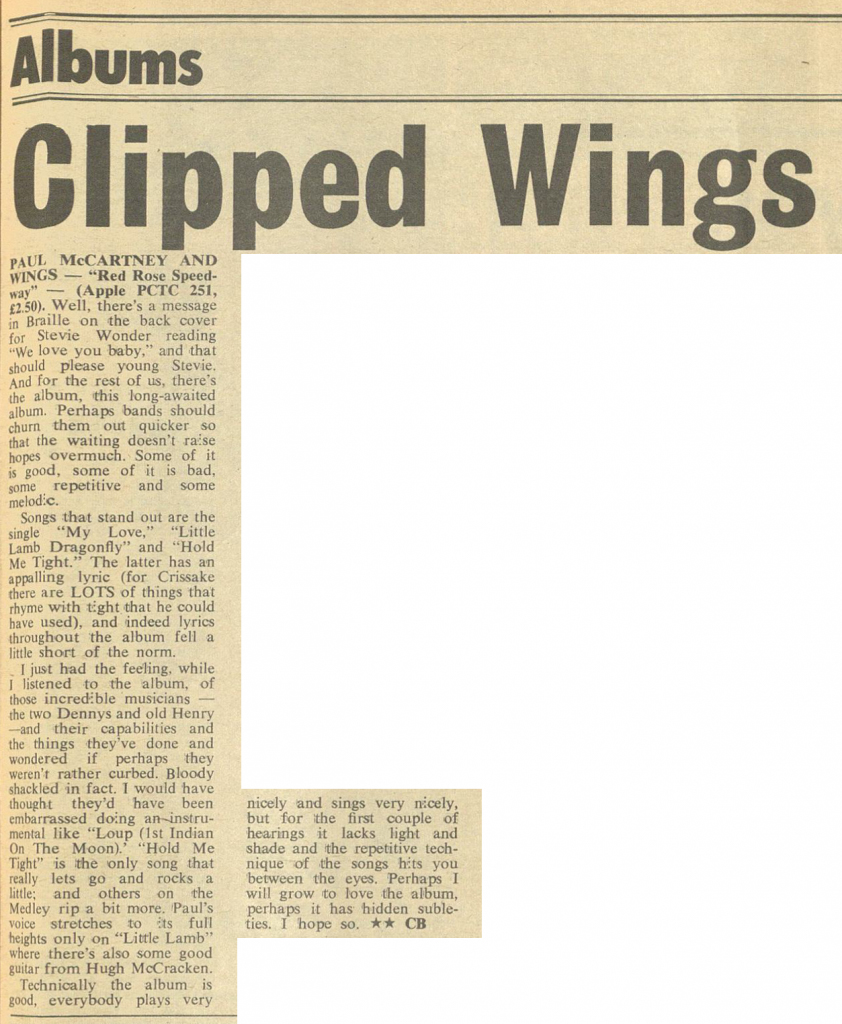
‘Red Rose Speedway’: The title was inspired by Rose, Paul and Linda’s housekeeper, a redhead. Apparently, Rose was rushing around making breakfast one morning when Paul suddenly said, “I know, Iet’s call it ‘Red Rose Speedway.’…..
From Wings Fun Club newsletter N°1, 1974
Firstly let’s talk about “Red Rose Speedway”. Where did the title come from?
That came from Paul. We were over at his place one night and he got out this book called “Tales Of The Truth” or something like that and we went through it to get a name. There were all these different words and phrases in it which were really good sounding and Paul and Linda just saw something about “Red Rose Speedway” so that was it.
See, originally this was supposed to be a double album because we’d put down enough tracks for one and everybody said great, a double would be a gas and I think I was the most furious about it not being a double because I wanted the band to be seen for what it could offer, you know, instead of just like being James Paul McCartney, you see what I mean. But that’s cool too.
Henry McCullough – From interview for Sounds, April 14, 1973
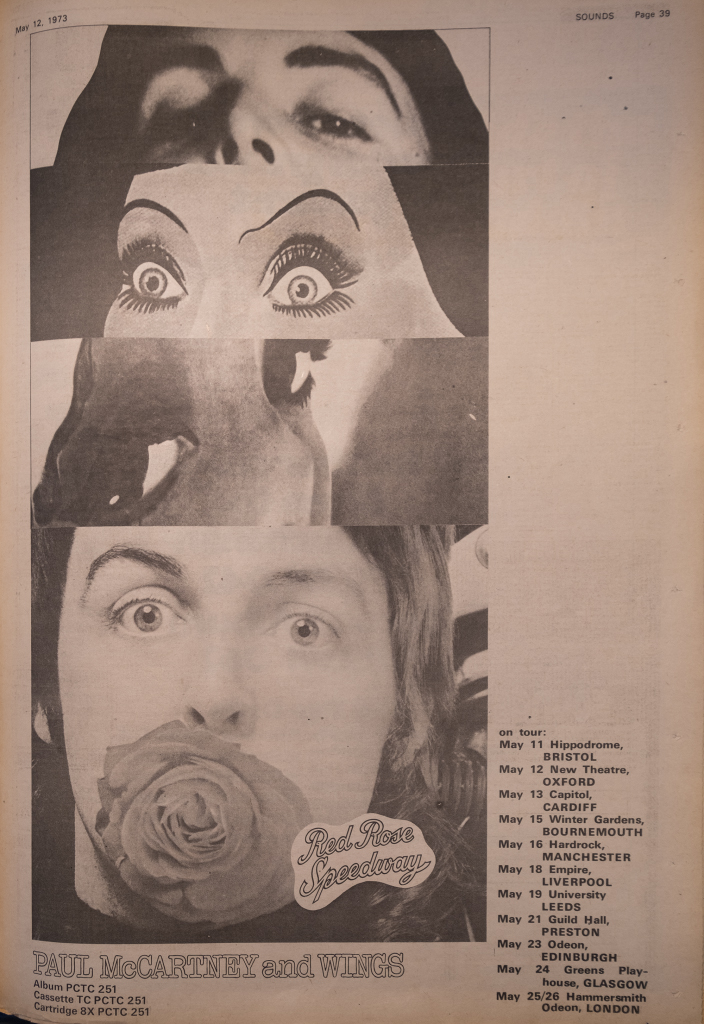



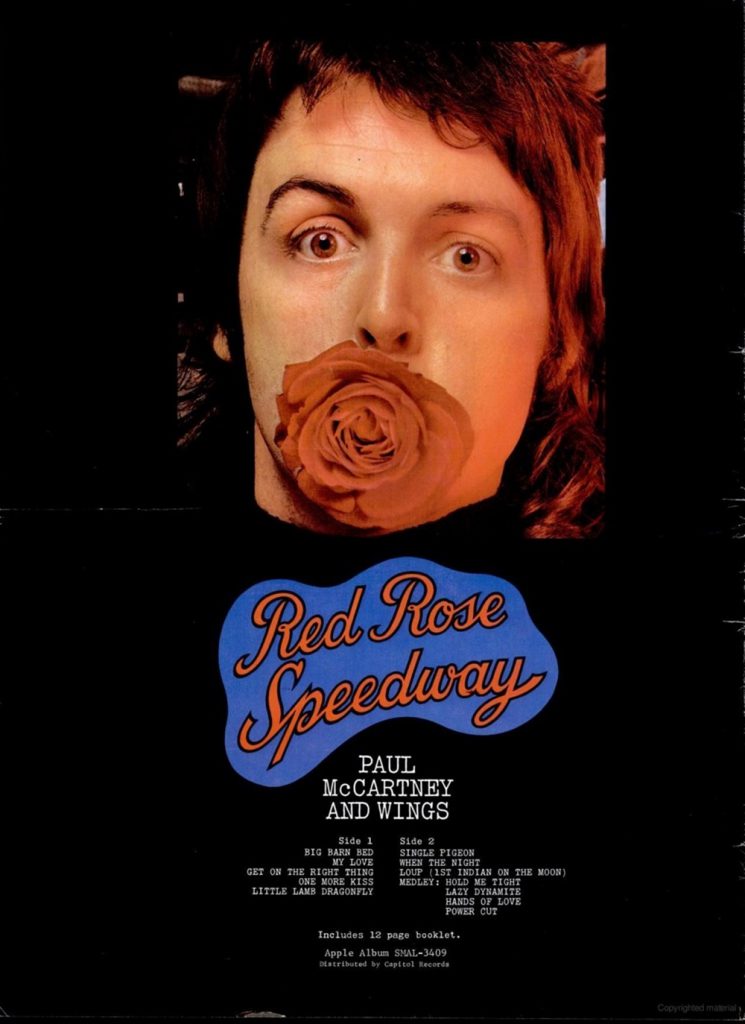
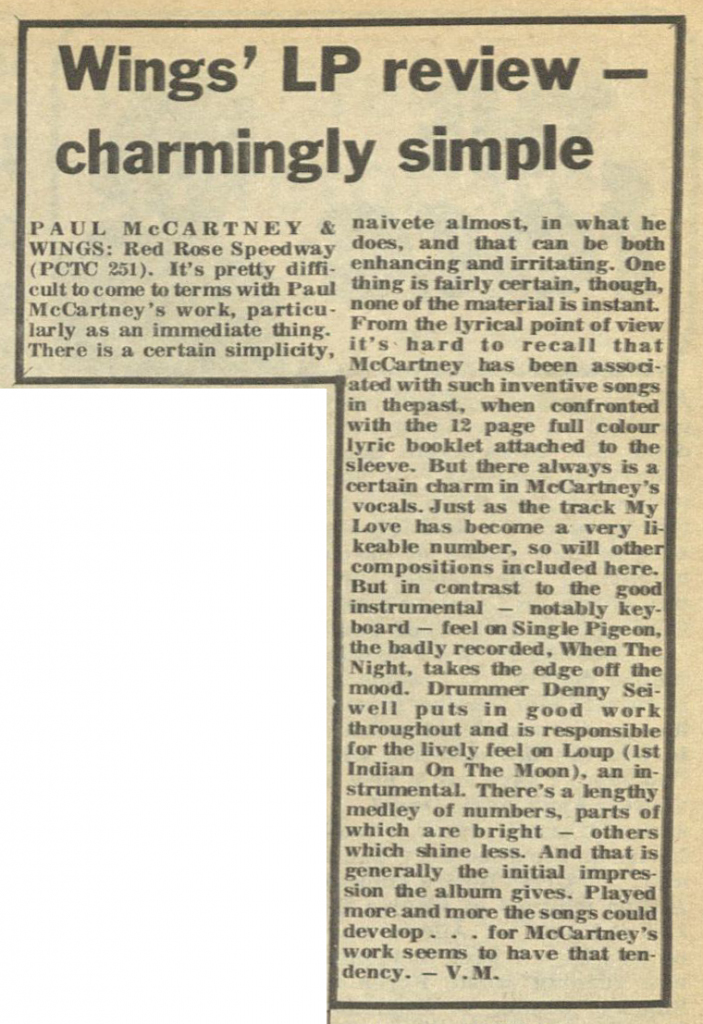
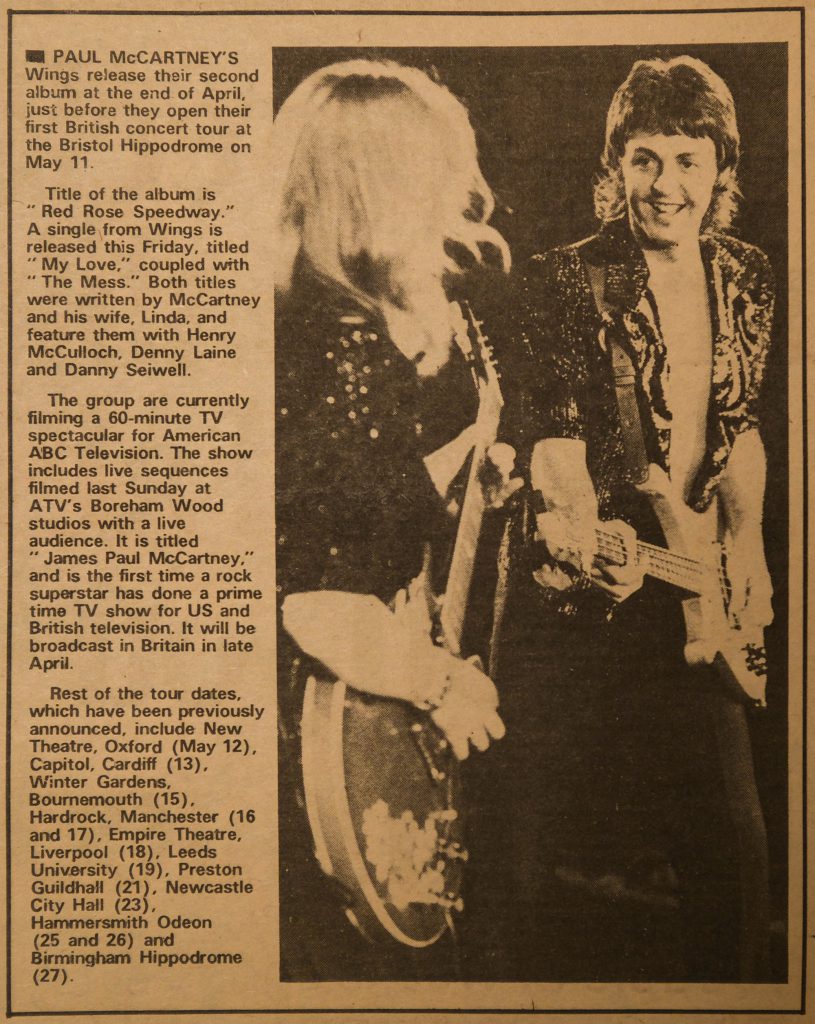
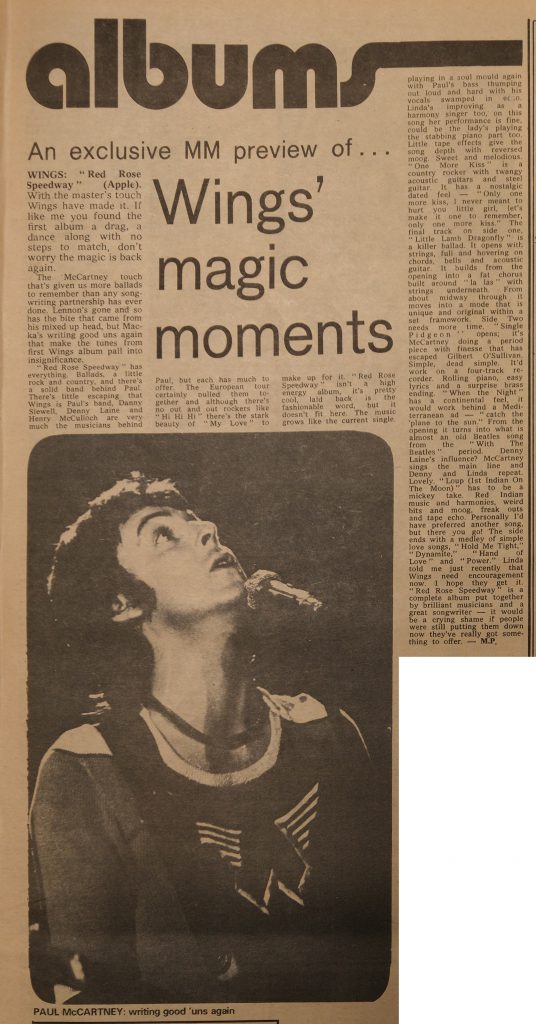
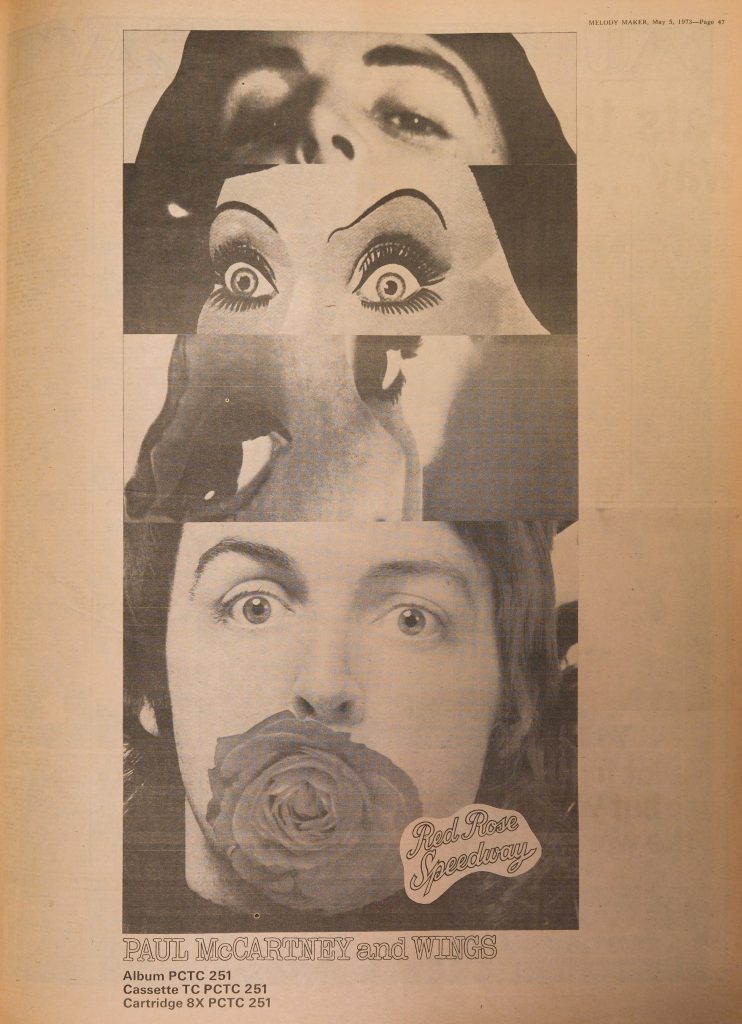
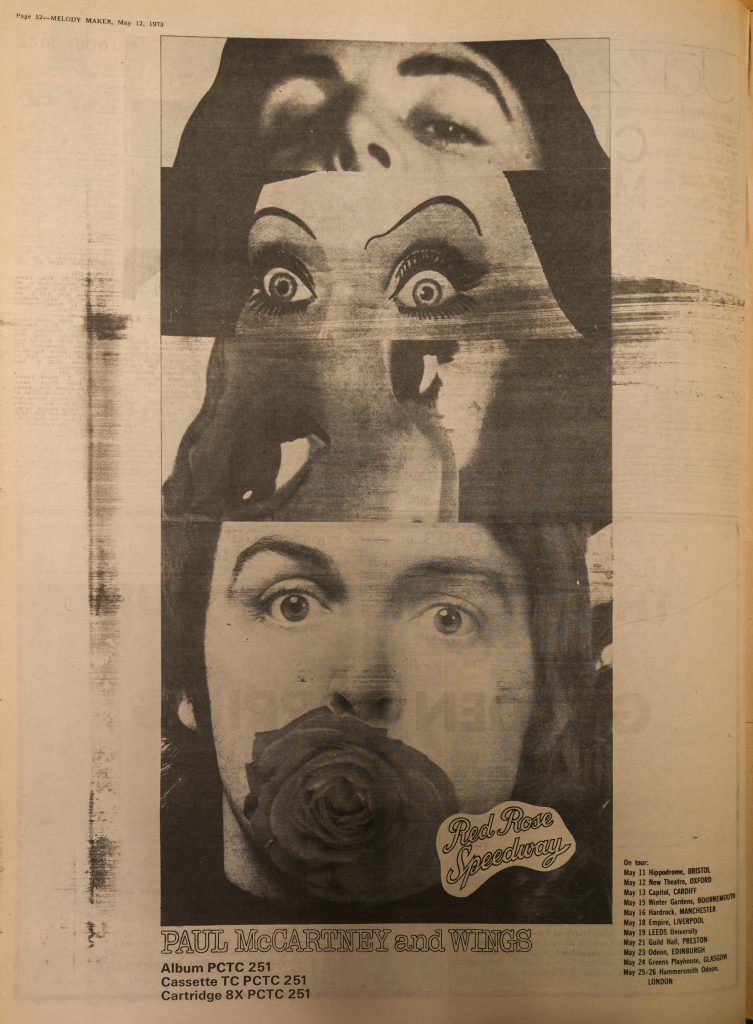
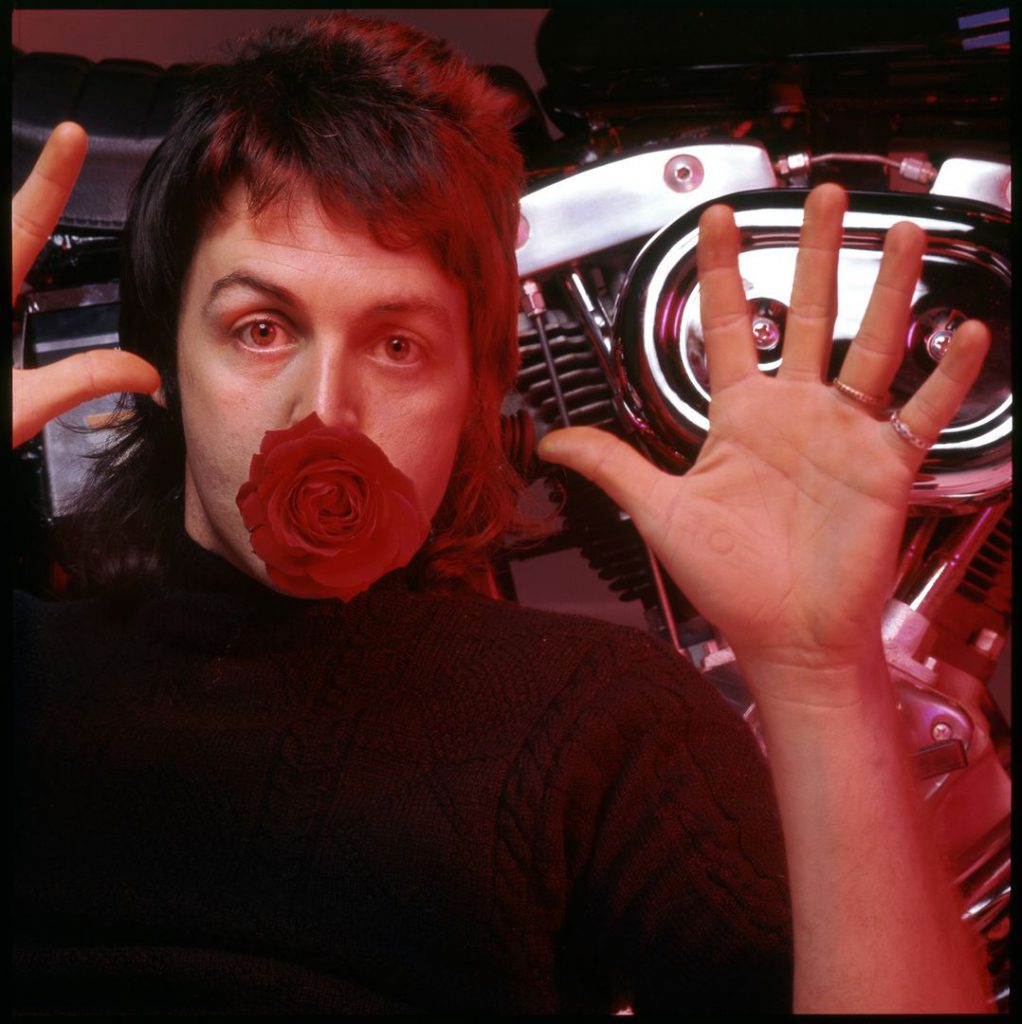
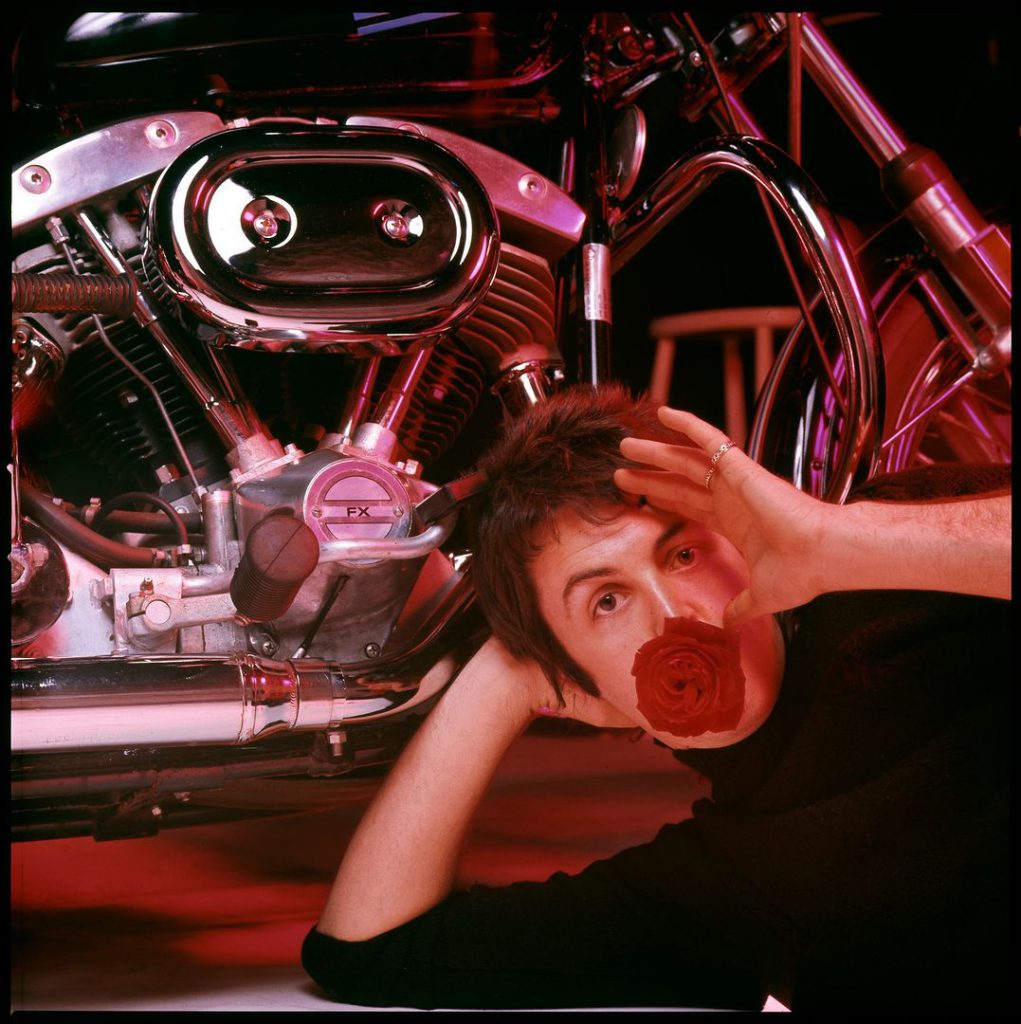
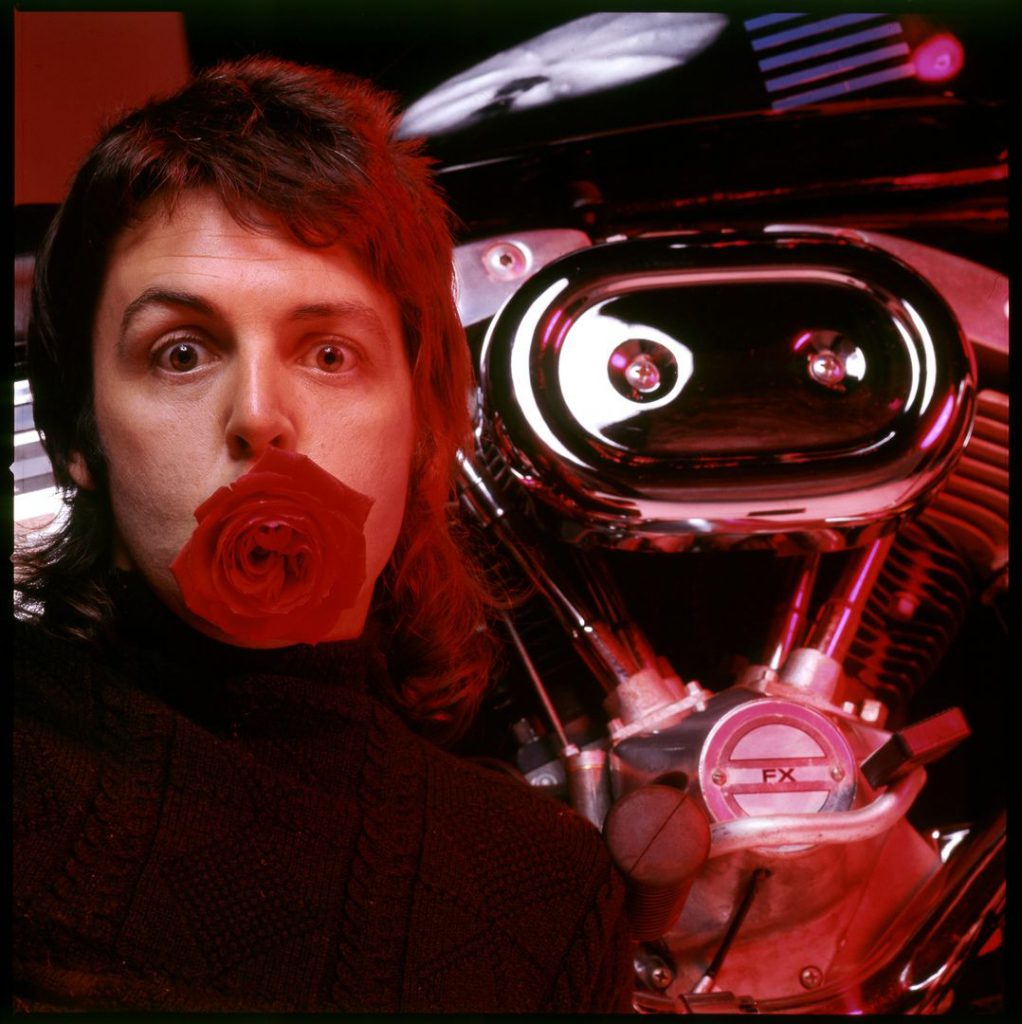
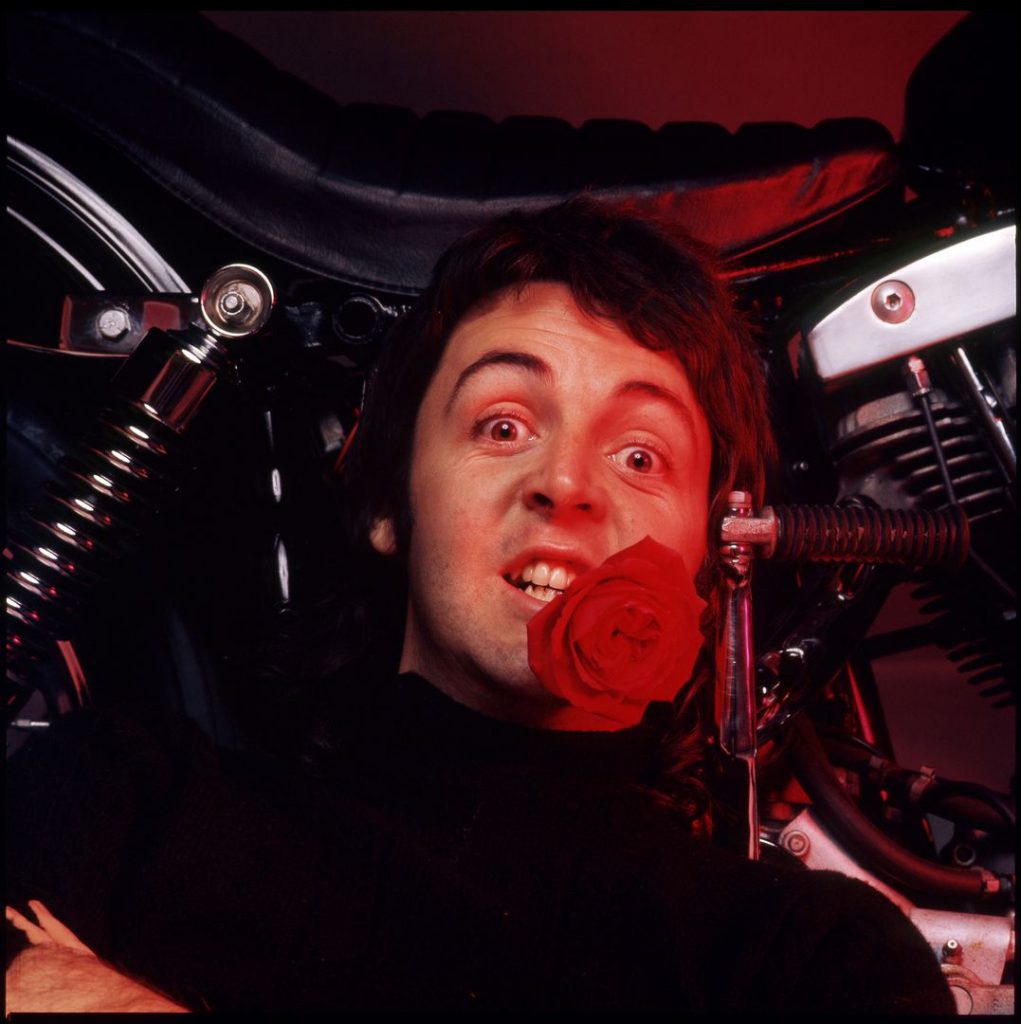
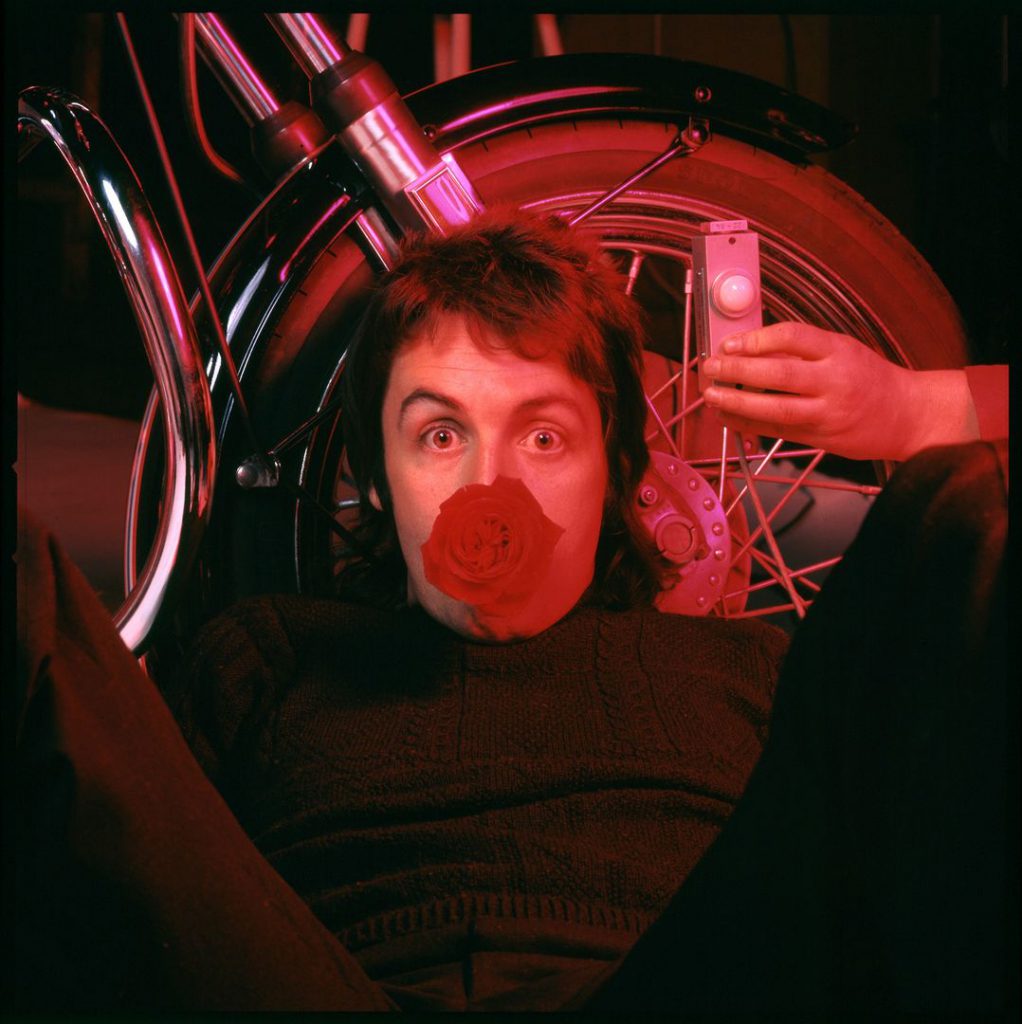
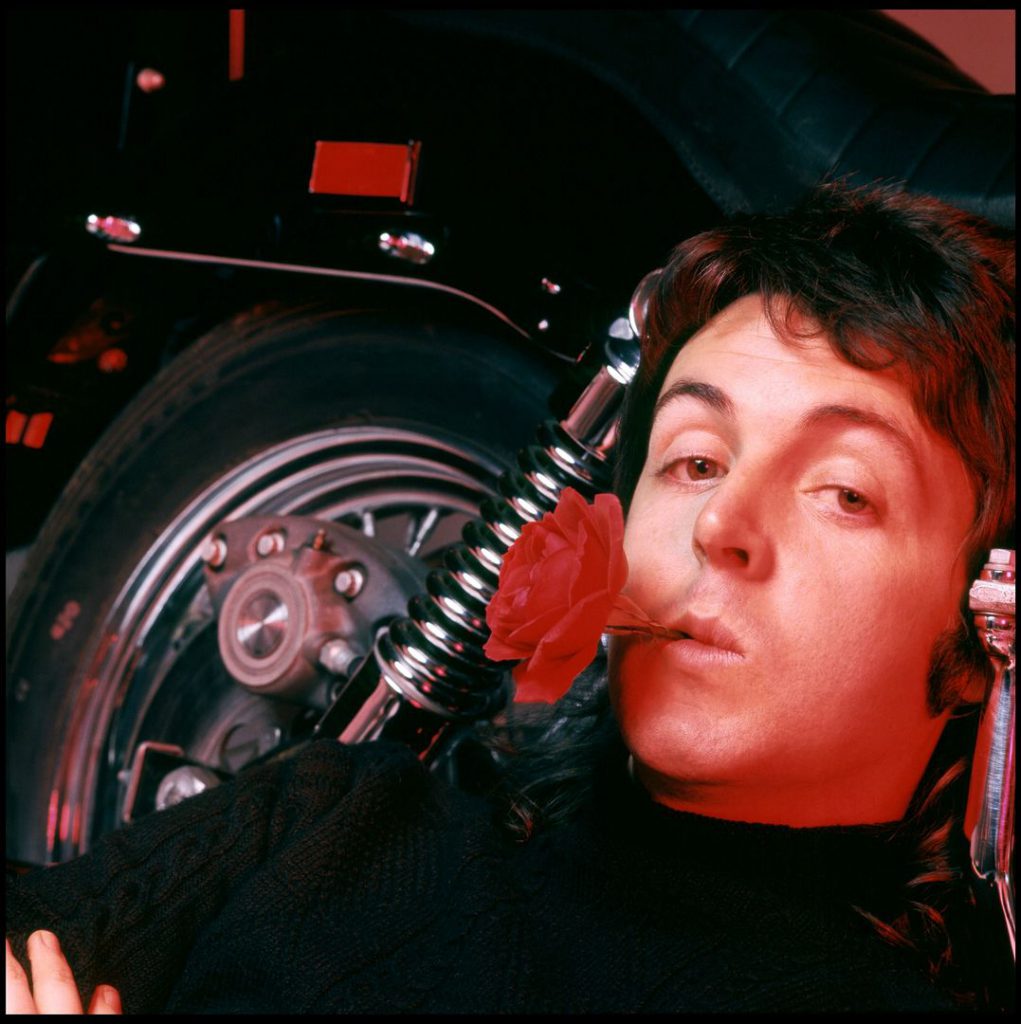
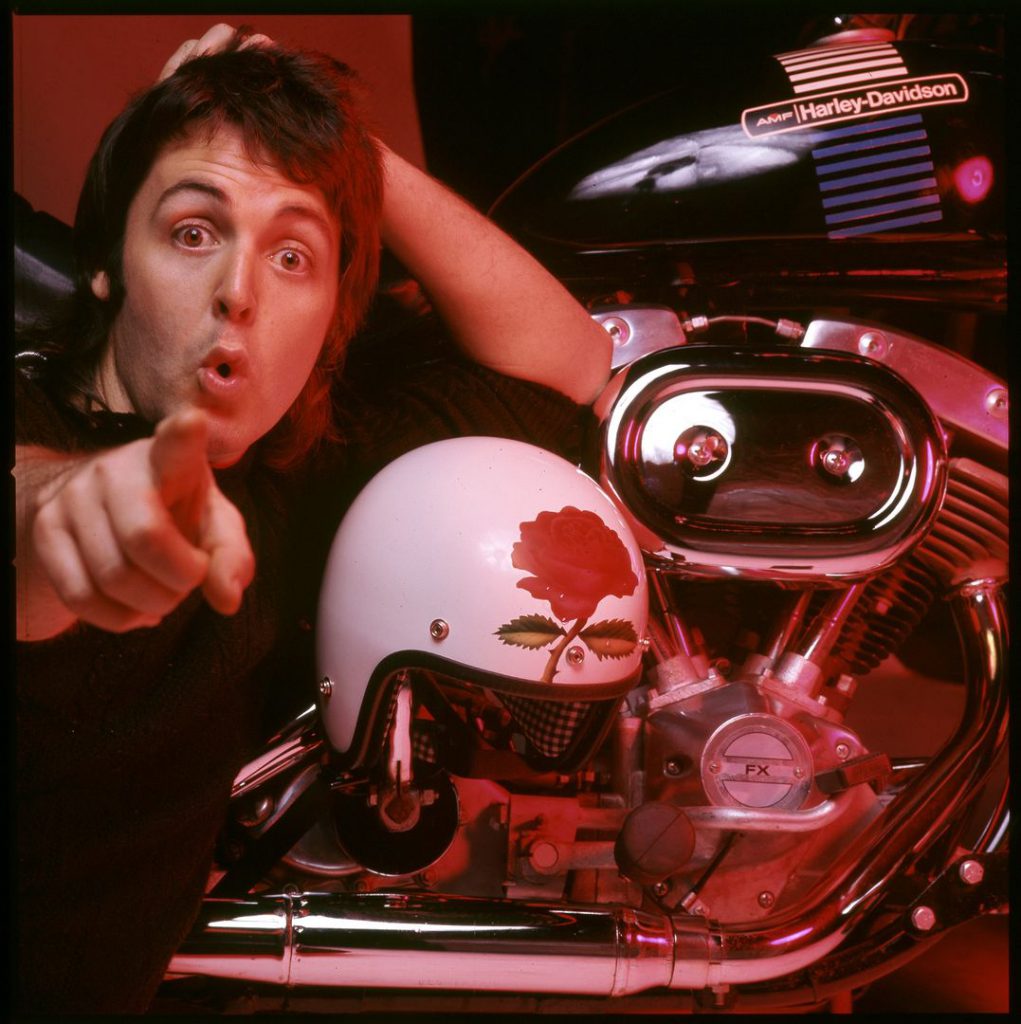
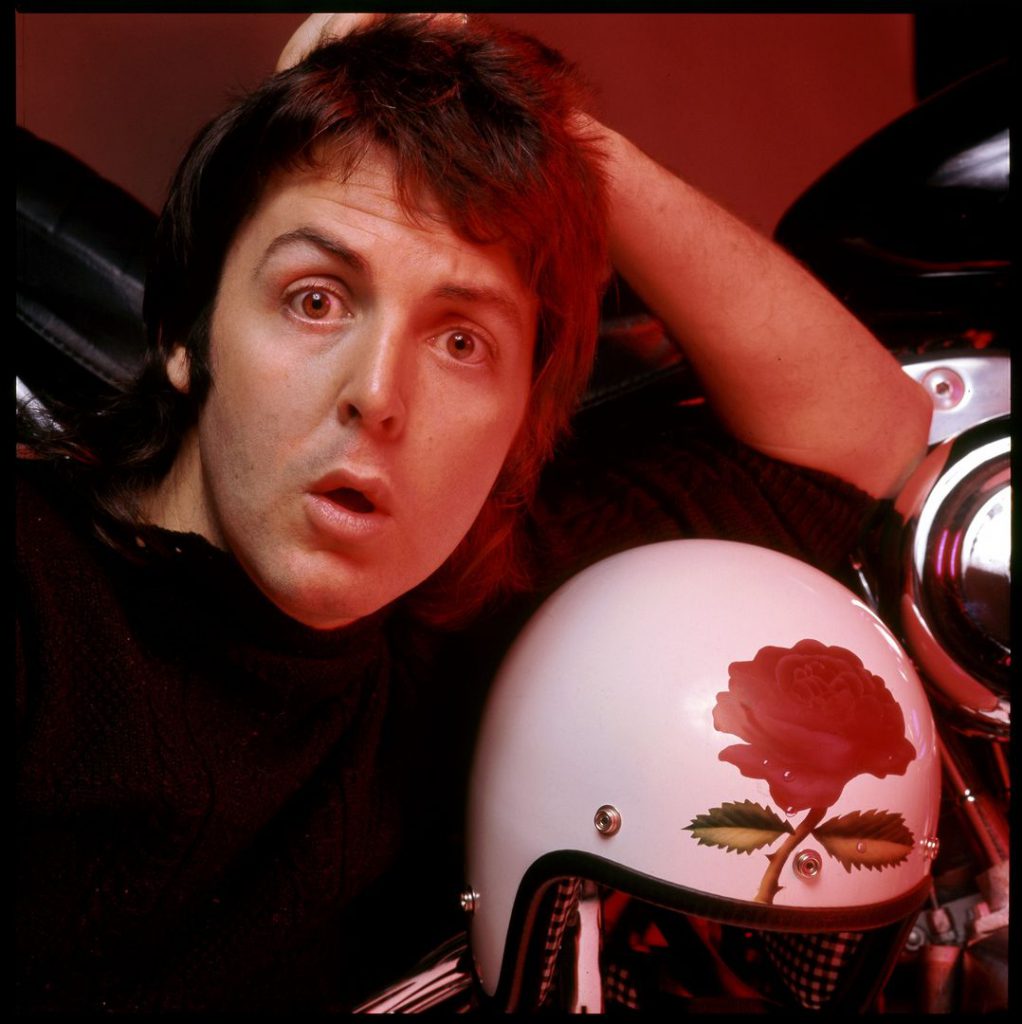
Nice one, Paul
PAUL McCARTNEY AND WINGS: “Red Rose Speedway” (Apple). When Paul McCartney split, back in the long ago when the Beatles were swatting each other and not a few hard shells were cracking under the blows, there were those who doubted whether he would ever make a good record again without the edgy brilliance of John Lennon to offset his more melodic – face it, more overtly middle-class tunesmith aspirations.
To be sure, McCartney’s first LPs, “McCartney”, “Ram”, and “Wings” did little to allay the fears that the world had lost a majestic influence and gained the doubtful substitute of another soft-centred cabaret act.
The fact that ducks on the wall can sometimes be appealing quite escaped McCartney’s many critics (who, if the truth be known, were probably more Incensed at Paul’s legal actions of the time than at his music; they fastened their prejudices accordingly).
So, with John Lennon cast in the role of Working Class Hero (when he’s even more lower-middle than Paul) and with the anti-bourgeois chic that then prevailed, poor McCartney lost out all down the line.
Well folks, this time Paul has really done it; he’s really made a nice record. Certainly “Red Rose Speedway” is lightweight, sure it’s no intellectual posture. But, with all the current heaviness and after-me-the-apocalypse brain studs around, I for one am bloody pleased to discover a lightweight record that not only fails to alienate, but actually succeeds in impressing via good melodic structure, excellent playing and fine production. It altogether makes my day.
“Red Rose” comes in a complicated booklet package, lined with photos (some by NME’s Joe Stevens of blessed memory) and some remarkably sensuous archive collages.
First track is “Big Barn Red”, a compact bouncer that displays all of Paul’s natural feel for swing and lightheartedness that used to counterpoint Lennon’s deeper susceptibilities in the, er, other band.
This moves into “My Love”, which is one of three tracks that typify McCartney at his best. It’s a big, luscious ballad in the style of “Long And Winding Road” or “She’s Leaving Home” and it shows how Paul can, when he wants to, make extremely clever interval shifts -all the while featuring some terrific Harrisonesque lead breaks from Henry McCulloch.
“Get On The Right Thing” is the weakest track, I feel, because it can’t quite make up its mind as to what kind of song it really wants to be. The same slick time and interval shifts are displayed but the obvious care taken fails to conceal a certain lack of direction. But I’m happy to say it’s the odd man out on this otherwise very praiseworthy album.
This is followed by a homey little song, “One More Kiss”: totally unpretentious, nice melody, good feel.
Then comes the Track Of The Album, “Little Lamb Dragonfly”, which simply soars. Based on a series of 12-string figures from Denny Laine and Henry, the richness of the production totally compensates for the Beatrix Potter lyrics and, in fact, makes them work even better. The whole album is justified by this track, and it’s the one I keep returning to when trying to pin down an overall critical judgement.
Turn over – and a quickie, “Single Pigeon”, to kick off with. Pleasant, light and short. Just as it should be. This is followed by the most Beatle-ish track (in the sense of backing harmonies) which is “When The Night”; and then, in turn, by the album’s curio. “Loup”, an electronic excursion into Floydland with McCartney on Moog while Mrs. McCartney. Henry, Denny and Denny Seiwell chant a la Yardbirds “Still I’m Sad”. No lyrics at all.
Behind the Moog and the chant, Henry and Denny Laine swop biting guitar phrases. It’s nice, and interesting – and also it’s something of a filler. I pass.
The final track is a medley of four tunes, “Hold Me Tight”, “Lazy Dynamite”, “Hands Of Love” and “Power Cut” (from the sleeve artwork I also expected one called “Seaside Woman” but, for some reason, it hasn’t turned up on the record).
My main criticism of the album is its lack of a real rocker. The McCartney who sang “Get Back” and “Long Tall Sally” seems, sadly, to have vanished and I would have liked a somewhat harder core to set my teeth into. But on the level it’s aimed at, goodtime music (just what Paul originally said he wanted to do, if you remember), it works.
“Red Rose Speedway” is certainly the best thing McCartney’s done since the Great Demise, and I also think it’s the best thing he’s likely to do with this band. Not, I hasten to add, because of any lack of talent, but simply because Wings” original briefing went no further than this.
Paul makes his stand here and as far as I’m concerned he’s proved his point. And I also think that in the future he’s going to be able to look back on the last three years without cringing – which is more than I suspect Lennon will be able to do.
TONY TYLER
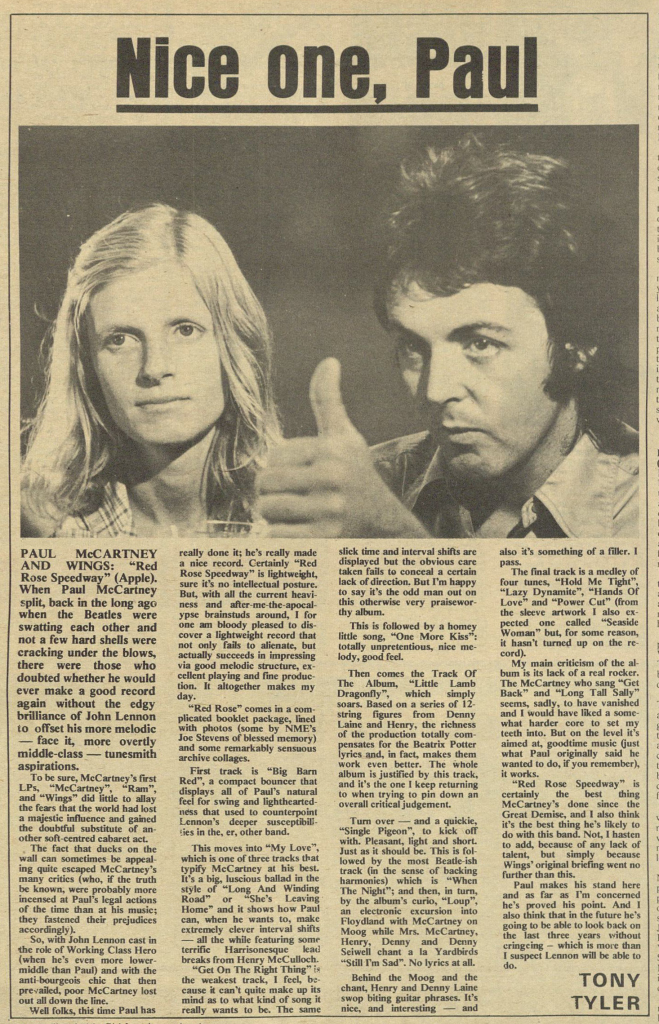
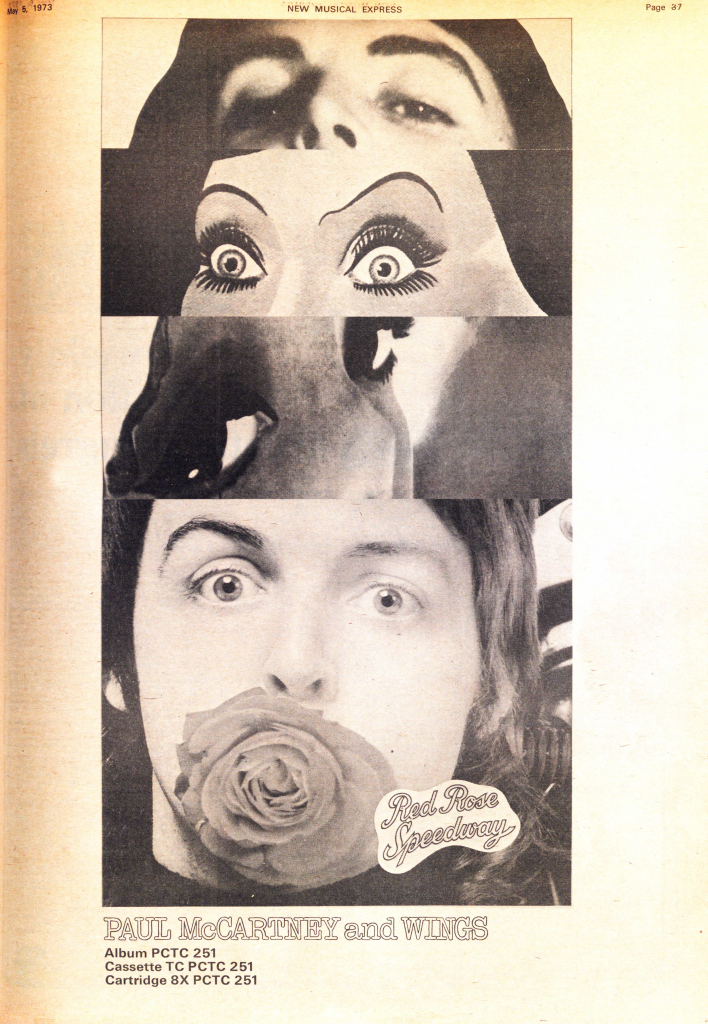

Notice any inaccuracies on this page? Have additional insights or ideas for new content? Or just want to share your thoughts? We value your feedback! Please use the form below to get in touch with us.
Wayne "Exiled from America" Manzo, • May 21, 2023 • 2 years ago
When I was Shanghai'd to Michigan from the Ice Cream Scooper job at Bischoff's in Teaneck NJ
(I was a Stoner Loser with no future) I was put on a Greyhound Bus to Northern Michigan and it was
my first Greyhound bus ride. I had an Army Duffel Bag with clothes and my other little belongings were
shipped up to the Upper Michigan by my Witch Sisters. I was forced to listen to other peoples music and
that meant old Albums of the siblings and one album was Red Rose Speedway. Well, on the bus as
it left the Port Authority of NY was "Paul and Linda McCartney" or very good Dupes of them. I peered
over the seats a few times and could not believe Paul and Linda on the bus with me as I'm being sent
to my certain death to an Engineering school in Northern Michigan. Too bad I was not smart enough to realize that they make automobiles in Detroit 600 miles South of Houghton MI and the only thing in Houghton were
Moose and Wolf__it was a prison. Who Shanghai'd me to Michigan? Psycho Witch Madonna Ciccone from
Bay City. What happened to me? I earned a PhD in Automotive Engineering then was played to Cleveland
and a Chump job at NASA and was destroyed by Army Col Madonna Wedding__hey, where did they build
the Rock n Roll Museum? Cleveland? What a coincidence. I should have stayed at the Ice Cream Scooper job and lived in a tent behind the store. Ha Ha Ha!
The PaulMcCartney Project • May 30, 2023 • 2 years ago
What a story - thanks for sharing, Wayne !